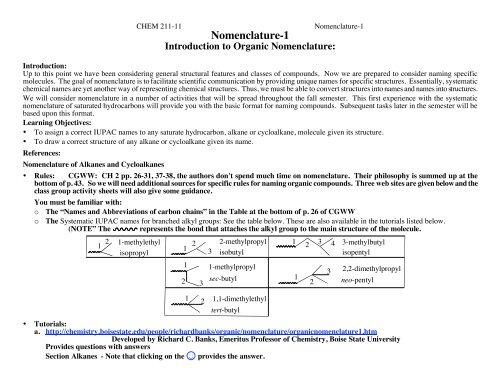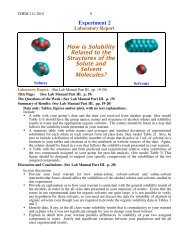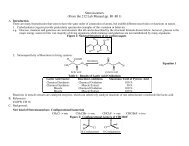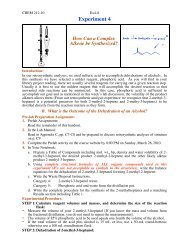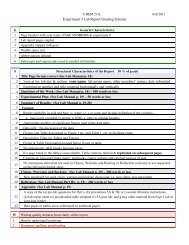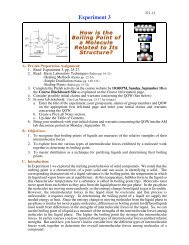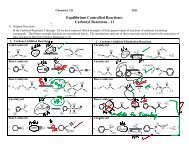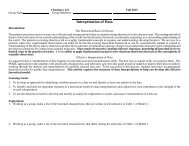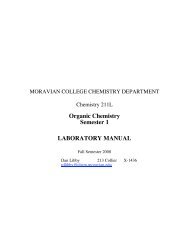Nomenclature-1 - Moravian College Chemistry Department
Nomenclature-1 - Moravian College Chemistry Department
Nomenclature-1 - Moravian College Chemistry Department
Create successful ePaper yourself
Turn your PDF publications into a flip-book with our unique Google optimized e-Paper software.
CHEM 211-11 <strong>Nomenclature</strong>-1<strong>Nomenclature</strong>-1Introduction to Organic <strong>Nomenclature</strong>:Introduction:Up to this point we have been considering general structural features and classes of compounds. Now we are prepared to consider naming specificmolecules. The goal of nomenclature is to facilitate scientific communication by providing unique names for specific structures. Essentially, systematicchemical names are yet another way of representing chemical structures. Thus, we must be able to convert structures into names and names into structures.We will consider nomenclature in a number of activities that will be spread throughout the fall semester. This first experience with the systematicnomenclature of saturated hydrocarbons will provide you with the basic format for naming compounds. Subsequent tasks later in the semester will bebased upon this format.Learning Objectives:• To assign a correct IUPAC names to any saturate hydrocarbon, alkane or cycloalkane, molecule given its structure.• To draw a correct structure of any alkane or cycloalkane given its name.References:<strong>Nomenclature</strong> of Alkanes and Cycloalkanes• Rules: CGWW: CH 2 pp. 26-31, 37-38, the authors don't spend much time on nomenclature. Their philosophy is summed up at thebottom of p. 43. So we will need additional sources for specific rules for naming organic compounds. Three web sites are given below and theclass group activity sheets will also give some guidance.You must be familiar with:o The “Names and Abbreviations of carbon chains” in the Table at the bottom of p. 26 of CGWWo The Systematic IUPAC names for branched alkyl groups: See the table below. These are also available in the tutorials listed below.(NOTE” The represents the bond that attaches the alkyl group to the main structure of the molecule.2 1-methylethyl1 21isopropyl2113232-methylpropylisobutyl1-methylpropylsec-butyl1,1-dimethylethyltert-butyl11223343-methylbutylisopentyl2,2-dimethylpropylneo-pentyl• Tutorials:a. http://chemistry.boisestate.edu/people/richardbanks/organic/nomenclature/organicnomenclature1.htmDeveloped by Richard C. Banks, Emeritus Professor of <strong>Chemistry</strong>, Boise State UniversityProvides questions with answersSection Alkanes - Note that clicking on the provides the answer.
<strong>Nomenclature</strong>-1 2b. http://elchem.kaist.ac.kr/jhkwak/OkanaganPdb97/nomenclature/index.htmDeveloped by Professor emeritus at Okanagan <strong>College</strong> of the University of British Columbia, CanadaProvides naming rules and examplesSections:1. Introductions to these pages2. The IUPAC Systematic Approach to <strong>Nomenclature</strong>3. The AlkanesUnbranched AlkanesBranched AlkanesMonocyclic Alkanesc. http://www.acdlabs.com/iupac/nomenclatureDeveloped by Advanced <strong>Chemistry</strong> Development LaboratoriesGives detailed IUPAC rules for nomenclature.Sections:Recommendations 1979:A. Hydrocarbons:Acyclic Hydrocarbons/ A-1. Saturated Unbranched-chain Compounds and Univalent Radicals &/ A-2. Saturated BranchedchainCompounds and Univalent RadicalsMonocyclic Hydrocarbons/ A-11. Unsubstituted Compounds and RadicalsSummary of Rules for Naming Alkanes1. Find the longest continuous chain of CARBON atoms or the largest ring of CARBON atoms and use it to determine the base alkanename. Note: Atoms that are part of a ring cannot also be part of a chain. (See CGWW p. 26 for a list of base names.)2. Identify each substituent group attached to the base carbon chain and name it using the group name (See CGWW p. 26). If there are two ormore identical substituents in a molecule, they are named as "di-, tri-, tetra- etc. (See example in 7. below)3. For acyclic alkanes (not containing rings), number the base carbon chain from the end nearest the point of attachment of a substituent andassign each substituent a number based on its position of attachment to the main chain.4. For cycloalkanes, number the ring positions such that the sum of the position numbers will be minimum.5. Designate each substituent with the number of its position on the chain or ring. If more than one substituent is attached to the same position,each substituent should be numbered separately even if both substituents at a position have the same name. (See the example in 7. Below.)6. When two or more substituents are attached to the base chain or ring, list them alphabetically ignoring the di-, tri-, tetra etc. prefixes.7. In complex names, position numbers are separated from each other with commas and from words with dashes. e.gAcyclicCyclic3-ethyl-2,2,4-trimethylhexane4-ethyl-1-methyl-1,2-dipropylcyclohexane
Name the following:3 <strong>Nomenclature</strong>-1Draw structural formulas for the following compounds:ethylcyclopropane 2,5-dimethylhexane isobutylcycloheptane 2-methyl-3-(1-methylethyl)pentaneReflector’s Report Discussion:Identify the most important concepts you learned from this activity:Remaining Questions:Strategy Analyst’s Report Discussion:Look back at the process used to develop the items identified in the Reflector’s Report Discussion. How did the specific compounds used in the namingand drawing questions above help your group to clarify their understanding of process for naming alkanes and cycloalkanes?Out of Class Applications:A. Reading: CGWW CH 2 pp. 26-45, Web Page references in the Nomencalture-1 activity tutorial section.B. Activities1. Name the following: 2. Draw structural formulas for the following compounds:1-ethyl-1,4,4-trimethylcyclohexane6-ethyl-2-methyl-4,5-dipropyloctaneC. Applicable problems from CGWW: CHAPTER 2 - Problems: None


